Everything you need to know about columnar plums
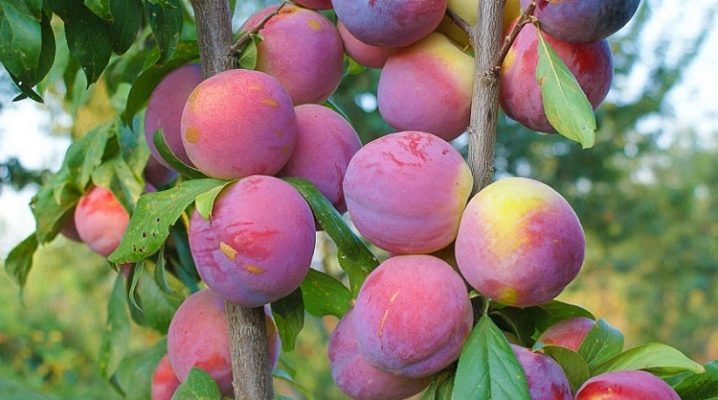
Plums with a columnar crown appeared in the second half of the 20th century in America. The unusual shape and high fertility of the plant attracted the attention of a huge number of gardeners, so the variety spread to different countries, including it appeared in Russia. In this article, we will describe in more detail the appearance of a columnar plum, and also consider the features of its planting, care and protection from pests.
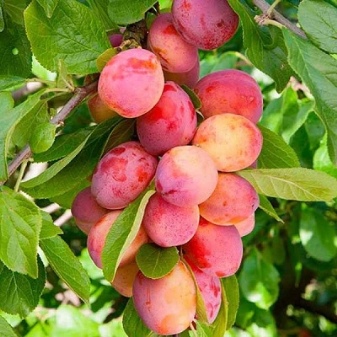
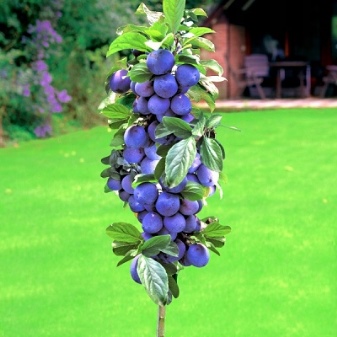
general description
The peculiarity of the columnar plum lies in the shape of its crown: the branches of the plant stretch upward, forming a living column. Unlike spreading trees, on which fruits grow chaotically, on a neat, harvested plum, the harvest densely covers each branch.
The columnar plum was not artificially bred - it appeared by chance in the garden of an American breeder. The owner noticed that on one of his Macintosh apple trees, due to some mutation, one of the branches grew vertically. A special part of the crown was densely hung with ripe apples, so the gardener decided to try to propagate a new kind of fruit plant. As a result, a few years later, the "Leader" apple variety appeared with a crown formed into a column. Having achieved success, the breeder decided to carry out the same operation with other fruit plants, so columnar types of pears and plums were later bred.
Plum with a columnar crown belongs to the subspecies Almond and the species Pink. Plum trees are usually very tall and have a large number of spreading branches. Such plants bear fruit well, but it is difficult to care for them - they often get sick and become infected with pests.
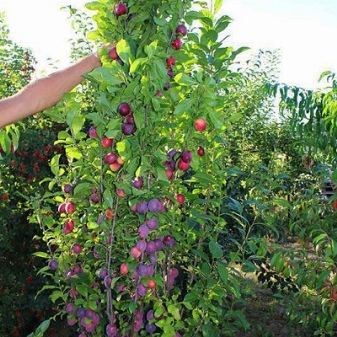

Column-shaped plums differ from classic varieties in the following ways:
- low trunk - the plant reaches a maximum of 2–2.5 m in height;
- sparse branches - a small number of branches, collected in a neat column, facilitates care and harvesting;
- the size of the branches - due to the peculiarities of the variety, the tree does not have thick branches, so the fruits are formed on small branches 14-25 cm long, which are called bouquet branches;
- number of fruits - during one season from a columnar plum, you can collect from 5 to 10 kg of fruits.
The yield obtained from a small, neat tree is less than from the classic spreading plum, but the harvested crown has its significant advantages. Thanks to the special structure of the branches, gardeners can plant much more plums in a small area. A lot of neat trees with modest fruiting will result in more yield than a few spreading plants.
The small tree is well lit by the sun's rays, and the sparse branches give pollinators easy access to nectar during the flowering period. On the market now you can find several varieties of such a plant: with yellow, blue and purple-reddish fruits. The columnar plum also has a drawback - its lifespan is shorter than that of other varieties.
After about 10 years of life, it begins to age and the fruiting rate begins to decline. In order to maintain the amount of harvest, it is necessary to periodically renew the garden, replacing old plants with young ones.

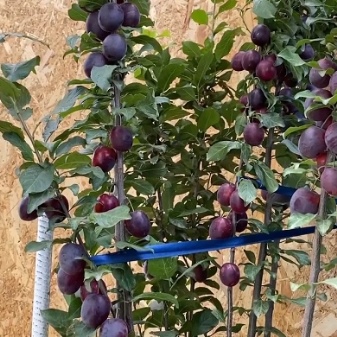
Overview of varieties
Varieties of small plums with a columnar crown differ in ripening speed, fruit shade and self-pollination ability.Also, each plant requires certain conditions for a high level of fruiting, so for each region of the country it is necessary to select a plant variety individually. We suggest taking a closer look at the best varieties of dwarf plums and their features.
- "Yellow". The main feature of the yellow plum is its early maturity, because the first ripe fruits can be harvested at the beginning of July. The fruit grows to a fairly large size, is round, yellow in color and has a sweetish aroma reminiscent of honey. The maximum tree height is 2–2.5 meters. The yellow plum is capable of self-pollination, but with some difficulties (heavy rains, infection and disease), it needs additional methods of pollination. The variety of the plant is resistant to frost and disease, therefore it is suitable for planting in the Moscow region, in the Urals and in the center of Russia.
- "Russian". One of the smallest types of columnar drains: its height is a maximum of 1.8 meters. Mid-season fruits - ripen at the end of summer. The fruits are purple-violet in color and small in size (about 40 g each fruit). Trees do not belong to the category of self-pollinated - for this they need cherry plum. The variety is suitable for the Urals, the Leningrad region and Siberia.
- "Honey". The variety grows up to 2–2.3 m in height and bears fruit with a bright yellow hue. The fruits are round in shape and gain approximately 50 g in weight. For pollination, the variety needs other types of plums: "Vengerka" and "Renklod Karbysheva". Honey plum is resistant to diseases and bitter frosts, therefore it is suitable for growing in the Moscow region, the center of Russia and Siberia.
- "Commander". The tree of this variety grows up to 2 meters in height, therefore it is considered dwarf. The skin of the fruit is red with a purple tinge, while the flesh is yellow, juicy and sweet. The fruits are great both for fresh consumption and for preservation. The Komandor variety is typical for the Leningrad Region and the Moscow Region.
- Angers. The dwarf columnar plum "Angers" bears fruit in late July and early August. Fruits are of a burgundy or purple hue, the average weight of each plum is 40 g. Fruits from such a tree are great for baking, because they have a pleasant sweet and sour taste. Best of all, the Angers variety takes root and bears fruit in the Urals.
- "Imperial". The variety provides a harvest of large plums (up to 55 g), which is why gardeners from all over the world love it. The columnar tree reaches a maximum of 2 meters in height, so it is very easy and convenient to pick the fruit. The fruits are blue, brownish-red and purple-burgundy, and all have a distinct sweet taste and soft texture.
Variety "Imperial" can be planted in the suburbs and the Leningrad region, because the plant is very fond of moisture.
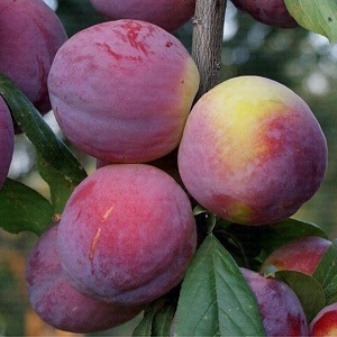
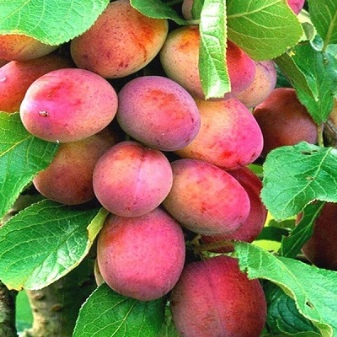
Landing
Dwarf plums with a column-shaped crown do not need unusual planting techniques - they are unpretentious and do not require special conditions. To plant a tree in open ground, it is enough to adhere to standard care recommendations, as for classic plums: choose a strong and healthy seedling, regularly loosen the soil after planting and water it correctly. Let's take a closer look at three important nuances when creating a plum garden.
- Time of year for disembarkation. In the southern regions of the country, it is necessary to plant columnar plants in the fall, and in the northern regions and in the Urals - in the spring, after the snow melts and the night frosts stop.
- Location. Trees in the Pink family love sunlight and should be planted in well-lit areas. The most suitable soil is with a groundwater level from 1.5 to 1.7 m deep.
- Landing technology. Form a row of holes 35-40 cm deep spaced at least 60-70 cm apart. The width between the rows should be between 1 and 1.5 m. At the bottom of each hole, place 2.5-3 kg of humus-rich soil (planting chemistry cannot be used: it will burn young roots).Carefully place the seedling in the hole, straightening the roots, and cover the free space with clean soil. As a result, the place where the root passes into the trunk should rise 2–4 cm above ground level.
Immediately after planting, the plums can be watered with a light growth stimulant solution. For example, "Heteroauxin" or "Kornevin" diluted in water. After 2-3 weeks, the adopted seedlings must be re-watered with the solution, carefully observing the proportions.


Care
Over the years of working with fruit trees, gardeners have found simple methods of growing a rich harvest. In order for your garden to bear fruit well, it is enough to follow a few simple rules of care.
Watering
Best of all, dwarf trees of the Pink family grow and bear fruit in moderately moist soil, and plants are also very fond of regular watering. They need abundant soil moisture once a month for three seasons: spring, summer and autumn. In the case when the weather is hot and dry for a long time, watering should be done more often.
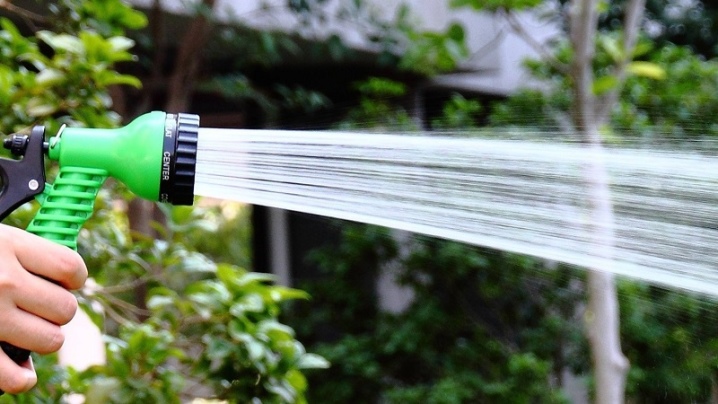
Top dressing
For the plum garden to be healthy, give a bountiful harvest and the fruits are juicy and tasty, it is very important to provide the plants with feeding correctly and in a timely manner. Most often, gardeners use a urea solution to fertilize the soil: 50 g of the substance is dissolved in 10 liters of liquid and the seedlings are watered with the finished mixture. Each tree consumes approximately 2–2.5 liters of water with top dressing. In the first year after planting, top dressing must be carried out 3 times:
- the first - in the spring, immediately after the appearance of the buds;
- the second - two weeks after the first watering;
- the third - 14 days after the second fertilization of the soil with a mixture of urea and water.
If in the first year a young seedling begins to bloom, it is necessary to remove all the inflorescences before the fruit sets. A young plant will not cope with growing fruits - it will die if the first flowers are not picked.
Further, for 3 years, the columnar plum will feed on the fertilized soil laid down during planting, so no additional feeding is required. In the 4th year of life, the time comes for regular fertilization of the soil once a season:
- in the spring, the soil is fertilized with nitrogen;
- in the hot summer, a solution with potassium is added under the trees;
- in the fall, top dressing should contain phosphorus.
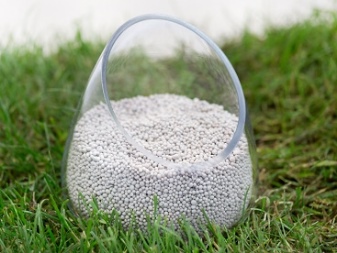
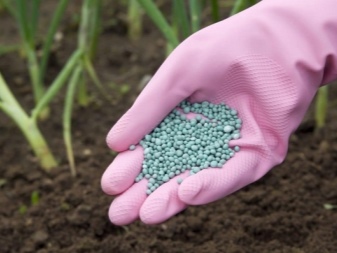
Pruning
It is very easy to form the crown of a dwarf plum, because initially there are not so many extra branches on it. It is recommended to trim the tree in the spring - before the buds appear on it. A spring haircut is the least harmful to the plant, so this pruning scheme is suitable even for novice gardeners.
It will take very little time to properly trim the columnar crown - you only need to remove the broken and dry branches. Also, the formation includes cutting off a few extra shoots that interfere with the development of fruit branches. Trees do not need an autumn shearing - all the necessary manipulations are performed in the spring.
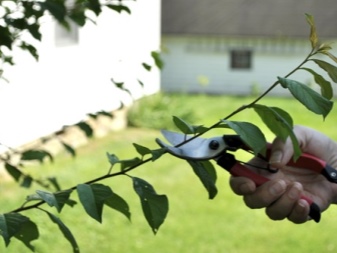
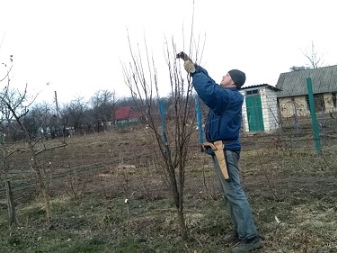
Mulching
After planting seedlings in open ground, it will take some time for them to take up and adapt to the new environment. To optimize the conditions will help a special covering of the soil - mulching. Covering the soil with a protective layer prevents the growth of weeds, death of seedlings from temperature extremes, drying out and water imbalance.
The most suitable mulch for fruit trees is compost from sawdust and small wood chips. The material must be laid around the tree trunk in spring, the thickness of the flooring should not exceed 7-9 cm. During the season, mulch will have a positive effect on the condition of the soil and will provide the fruit tree with useful microelements as a result of the decomposition of natural raw materials. In addition to sawdust and wood chips, mixtures of different materials such as tree bark, leaves, grass cuttings, straw and paper can be used as mulch.
Each type of mulching assumes a different thickness of the protective layer, for example, mulching with bark should be from 5 to 10 cm thick, and with paper - no more than 0.5 cm.

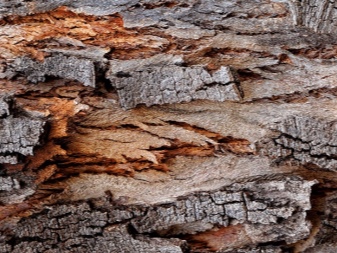
Preparing for winter
For the first few years after planting, all fruit plants are difficult to tolerate the cold, so even frost-resistant young dwarf plums must be protected from hypothermia before winter. The procedures are carried out after the last autumn watering. Young trees are protected in several ways:
- top dressing - a nutrient solution containing phosphorus and organic fertilizers will help plums survive the winter easier;
- shelter with organic materials - before the onset of cold weather around the trunk, it is necessary to decompose the needles (it will protect the seedlings from rodents) and a layer of organic materials, consisting of hay and fallen leaves (prevent frostbite and death of roots);
- snow cover - the method is used in especially snowy winters, trampling down the additionally collected snow around the trees.

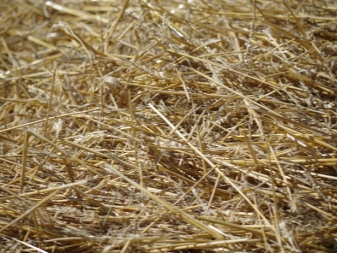
Diseases and pests
Columnar Plum is a very disease resistant variety, but even it can get sick if its roots or crown have been damaged. If signs of disease or pest infestation appear, act quickly. Check out the most common ailments of fruit trees in order to recognize and cure garden plants in time.
- Coccomycosis. The reason is too much moisture in the soil. During illness, the leaves of the seedling become covered with red spots and begin to fall off. To stop the disease, prepare a solution of copper oxychloride or Bordeaux liquid, then use a spray bottle to spray all trees infected with coccomycosis.
- Clasterosporium disease. With clotterosporia, brown circles appear on the plum leaves, burning them through and through. The culprits of this process are pathogenic fungi. To stop the spread of symptoms, use Topsin-M, carefully following the instructions from the instructions.
- Gommoz. If the bark of trees on the trunk and branches after winter is covered with resinous drops, the plums get sick with gommosis. The causes of the disease are several factors at once: hypothermia, excess moisture and too much fertilizer. Plants will be cured by spraying with a 1% solution of copper sulfate.

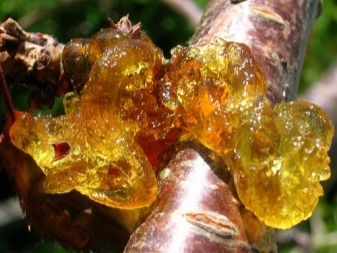
Harvesting and storage
For each variety, the harvest takes place at different times, depending on the characteristics of the particular variety and the place of planting. Most of the trees planted in the south of the country begin to bear fruit in July or even earlier, and in the northern regions, ripe fruits do not appear until August.
Early and mid-ripening plums are harvested by gardeners within a few weeks due to the fact that ripening occurs gradually. Late fruits are usually harvested all at once, because they ripen at the same time. The surest way to test ripeness is to taste the plum. Fruits can acquire a beautiful color before ripening, so you cannot be guided by color. Here are some tips from gardeners for harvesting plums:
- it is better to remove fruits in dry weather;
- harvest crops that will be stored, sold or transported over a long distance, collect together with the legs: this will prevent premature spoilage from injuries to the skin;
- start harvesting from the lower branches, gradually moving from the ends of the branches to the trunk, then remove the fruit from the top of the crown using the same method.
To keep ripe plums for a long time, carefully remove the fruits so as not to damage the protective wax coating. Prepare small wooden crates for fruit with paper in the bottom and carefully place the fruit in them immediately during harvest. Store containers at temperatures between 1 ℃ and 3 ℃.
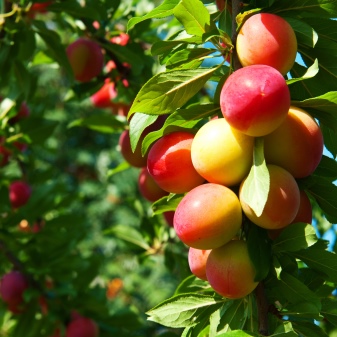
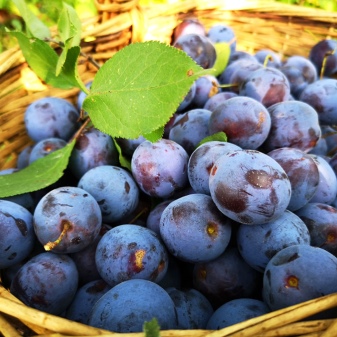













The comment was sent successfully.